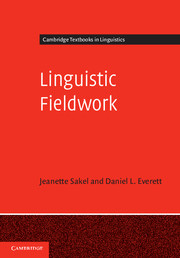2 - Fieldwork projects
Two examples
Published online by Cambridge University Press: 05 December 2012
Summary
This chapter guides you through aspects of two very different fieldwork projects:
Fieldwork on the morphosyntax of an Amazonian language from Bolivia: how to begin extracting information about the grammar from spoken language
Fieldwork on the language contact situation between Somali and English among immigrants in the UK: how to set up a research project, and what to take into account before starting the data-collection
This is a first opportunity to learn about – and try out – some of the fieldwork techniques discussed in this book. It will be an introduction to many of the techniques and terms discussed in later chapters. These include text recording, elicitation and transcription in 1. and how to find speakers, use picture stories, use sociolinguistic questionnaires, apply for funding and ethics applications in 2.
Fieldwork project 1. Mosetén in Bolivia: text-collection, transcription, analysis and elicitation
In this chapter we will introduce the basic principles of text-collection, transcription, analysis and elicitation. These are the cornerstones of ‘prototypical fieldwork’, generally employed in describing the morphosyntax of a language in order to write a grammar, but aspects of these methods are present in all types of fieldwork.
Information
- Type
- Chapter
- Information
- Linguistic FieldworkA Student Guide, pp. 10 - 25Publisher: Cambridge University PressPrint publication year: 2012
